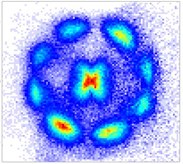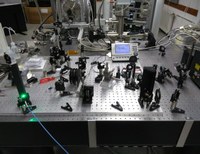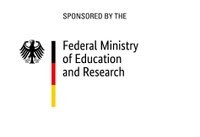Research activities
Research activities
Labs
Projects
Attosecond coincidence spectroscopy
Coincidence spectroscopy is very powerful technique for the investigation of multiple  photoionization in atoms and photoionization/photodissociation mechanisms in molecules. Our goal is to investigate electronic and nuclear dynamics in small molecules excited by an isolated or an attosecond pulse train. The subsequent electronic and nuclear dynamics is probed by means of a synchronized infrared field. Photoelectron/photoion spectrometers working in coincidence give the opportunity to disentangle the different photoionization and photodissociation channels, thus delivering a complete description of the molecular dynamics after the initial triggering event. Moreover this technique gives the opportunity to compare the dynamics in different molecules under the same experimental conditions. The successful implementation of this technique requires high-repetition rate attosecond sources.
photoionization in atoms and photoionization/photodissociation mechanisms in molecules. Our goal is to investigate electronic and nuclear dynamics in small molecules excited by an isolated or an attosecond pulse train. The subsequent electronic and nuclear dynamics is probed by means of a synchronized infrared field. Photoelectron/photoion spectrometers working in coincidence give the opportunity to disentangle the different photoionization and photodissociation channels, thus delivering a complete description of the molecular dynamics after the initial triggering event. Moreover this technique gives the opportunity to compare the dynamics in different molecules under the same experimental conditions. The successful implementation of this technique requires high-repetition rate attosecond sources.
Poster Säulenveranstaltung 2021
Coherent control and time-resolved experiments at Free Electron Lasers
Free Electron Lasers (FELs) operating in the extreme ultraviolet (XUV), soft-X-ray and hard 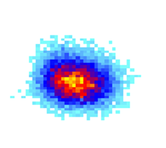 X-ray spectral range are unique facilities for the investigation of nonlinearities in these domain and for the implementation of the time-resolved experiments in the femtosecond and even attosecond domain.
X-ray spectral range are unique facilities for the investigation of nonlinearities in these domain and for the implementation of the time-resolved experiments in the femtosecond and even attosecond domain.
The FEL FERMI operating at Elettra in Trieste (Italy) is the only seeded FEL operating worldwide in this spectral range. Our research is focused on the exploitation of the unique characteristics of this laser for the demonstration of coherent-control techniques in the XUV spectral range [1,2]. Our future efforts will be devoted to the generation and characterization of attosecond pulse trains using this unique source and to time-resolved experiments on the femtosecond scale [3].
The European XFEL recently came into operation in Hamburg. XFEL is the largest X-ray FEL operating worldwide. Our research interests on this unique facilities are focused on the high-repetition rate (up 27000 shots per second) which will enable several experimental techniques, such as coincidence measurement and time-resolved coherent diffractive imaging, for the investigation of atoms and molecules under extreme conditions.
Poster Säulenveranstaltung 2021
Publications
[1] D. Iablonskyi et al. Physical Review Letters 119 073203 (2017)
[2] K.C. Prince et al. Nature Photonics 10 176 (2016)
[3] D. Iablonskyi et al. Physical Review Letters 117 276806 (2016)
Ultrafast time resolve electronic dynamics in atoms, molecules, and clusters
The investigation of electronic dynamics in 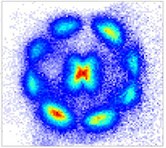 atoms and molecules is one of the principal objective of attosecond science [1]. A coherent electronic dynamics in these systems can be initiated either by an attosecond pulse in the XUV or soft X-ray range or by a few-cycle infrared pulse. A second pulse (usually a synchronized infrared field) is used to take snapshots of the system at a variable delay. In collaboration with the other groups in the physics institute (AG Stienkemeier and von Issendorff) we aim at investigating electronic dynamics initiated by the absorption of XUV photons from an attosecond pulse. Different experimental techniques including transient absorption [2], velocity map imaging, photoion spectroscopy [3] will be implemented in the experiments.
atoms and molecules is one of the principal objective of attosecond science [1]. A coherent electronic dynamics in these systems can be initiated either by an attosecond pulse in the XUV or soft X-ray range or by a few-cycle infrared pulse. A second pulse (usually a synchronized infrared field) is used to take snapshots of the system at a variable delay. In collaboration with the other groups in the physics institute (AG Stienkemeier and von Issendorff) we aim at investigating electronic dynamics initiated by the absorption of XUV photons from an attosecond pulse. Different experimental techniques including transient absorption [2], velocity map imaging, photoion spectroscopy [3] will be implemented in the experiments.
Publications:
[1] F. Lèpine et al. Chemical Physics Letters 578 1 (2013)
[2] M. Reduzzi et al. Journal of Physics B: Atomic, Molecular and Optical Physics 49 065102 (2016)
[3] M. Reduzzi et al. Physical Review A 92 033408 (2015)
Attosecond and femtosecond metrology
We develop new techniques for the temporal characterization of femtosecond  and attosecond pulses. Our work is usually based on the development and implementation of numerical codes based on the solution of the time-dependent Schroedinger equation to simulate physical effects, which can give access to specific parameters of an attosecond pulse (for example its carrier-envelope-phase [1]). Based on the strong-field-approximation we also develop new models and simulations to validate new methods for the reconstruction of the amplitude and phase of attosecond waveforms.
and attosecond pulses. Our work is usually based on the development and implementation of numerical codes based on the solution of the time-dependent Schroedinger equation to simulate physical effects, which can give access to specific parameters of an attosecond pulse (for example its carrier-envelope-phase [1]). Based on the strong-field-approximation we also develop new models and simulations to validate new methods for the reconstruction of the amplitude and phase of attosecond waveforms.
Recently we demonstrated a novel technique for the complete temporal reconstruction of few-cycle pulses in the visible and near infrared spectral range [2,3]. The technique is based on the recollision process responsible for the process of high-order harmonic generation. In combination with XUV spatial interferometry, the technique offers the unique opportunity to reconstruct pulses with an energy as low as a few tens of nJ. We plan to apply this technique for the complete reconstruction of visible weak optical pulses after their interaction with materials (for example surfaces). The complete reconstruction of the electric field should deliver information on the electronic dynamics in the sample.
Poster Säulenveranstaltung 2021
Publications:
[1] C. Liu et al. Physical Review Letters 111 123901 (2013)
[2] P. Carpeggiani et al. Nature Photonics 11 383 (2017)
[3] P. Carpeggiani et al. Journal of Physics B: Atomic, Molecular and Optical Physics 51 104004 (2018)
|
Laser sources development Laboratory
|
|
|
Phasenmodulierte Erzeugung hoher HarmonischerStart/End of project: 01.11.2019 - 31.10.2022 Funded by the DFG. |
Investigation of correlated electronic dynamics with attosecond pulsesStart/End of project: 01.07.2019 - 30.06.2022 Funded by the BMBF. During the last year, the Extreme Light Infrastructure Attosecond Light Pulse Source (ELI-ALPS) has started operation in Szeged Hungary. Intense trains and isolated attosecond pulses will be generated by high-order harmonic generation using unique laser sources.
|
|
|
|
Molecular Electron Dynamics Investigated by Intense Fields and Attosecond pulses (MEDEA)Project Manager: Prof. G. Sansone Start/End of project: 01.01.2015 bis 31.12.2018 Link: http://www.medea-horizon2020.eu/
This project is funded by the European Union's Horizon 2020 research and innovation program under Marie Sklodowska Curie Grant Agreement No. 641789 MEDEA. Two early-stage researchers, Praveen Kumar and Matteo Moioli, have been involved in the last two years in the project MEDEA. Praveen is currently working on the analysis of results obtained during an experimental campaign at the Free Electron Laser FERMI in December 2017, where, for the first time, the generation of trains of attosecond pulses by a Free Electron Laser was demonstrated.
Matteo is working on the development of an optical parametric amplifier operating at high-repetition rate (100 kHz) for the generation of few-cycle pulses, carrier-envelope-phase stable pulses. The source will be later on used as driving for the high-repetition rate attosecond beamline already installed in our laboratories. |
Quantum Dynamics in Tailored Intense Fields (QUTIF) DFG Priority Programme 1840
|
|
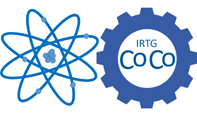 |
Cold Controlled Ensembles in Physics and Chemistry DFG funded International Research Trainin Group (IRTG 2079)
https://www.irtg-coco.uni-freiburg.de
|





